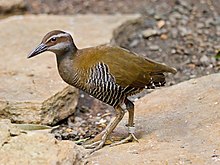Guam rail
| Guam rail | |
|---|---|
 |
|
| At the Cincinnati Zoo | |
| Scientific classification | |
| Kingdom: | Animalia |
| Phylum: | Chordata |
| Class: | Aves |
| Order: | Gruiformes |
| Family: | Rallidae |
| Genus: | Gallirallus |
| Species: | G. owstoni |
| Binomial name | |
|
Gallirallus owstoni Walter Rothschild, 1895 |
|
The Guam rail (Gallirallus owstoni) (Chamorro name: ko'ko' ) is a species of flightless bird, endemic to the United States territory of Guam. The Guam rail disappeared from southern Guam in the early 1970s and was extirpated from the entire island by the late 1980s. This species is now being bred in captivity by the Division of Aquatic and Wildlife Resources on Guam and at some mainland U.S. zoos. Since 1995, more than 100 rails have been introduced on the island of Rota in the Commonwealth of the Northern Mariana Islands in an attempt to establish a wild breeding colony. Although at least one chick resulted from these efforts, predation (largely by brown tree snakes and feral cats) and accidental deaths have been extremely high. A small number of birds potentially persists. In Mar. 31, 2017 Earth Optimism has been launched and a reintroduction program will be launched and currently Guam Rails will be returning and reintroducing back to the Wild in Guam.
Nine of the eleven species of native forest-dwelling birds have been extirpated from Guam. Five of these were endemic at the species or subspecies level and are now extinct on Guam. Two of these species, the Guam rail and the Guam kingfisher, are being captively bred in zoos in the hope that they can eventually be released back into the wild. Several other native species exist in precariously small numbers, and their future on Guam is perilous. Most native forest species, including the Guam rail, were virtually extinct when they were listed as threatened or endangered by the U.S. Fish and Wildlife Service in 1984.
It is a medium-sized rail about 11 inches (28 cm) in total length. The body is elongated and laterally compressed, particularly in the neck and breast regions, allowing the birds to move rapidly through dense vegetation. The plumage or feather color and pattern of both sexes is similar, however males can often be distinguished by their larger size. The head and back are brown. It has a grey eye stripe and throat and a dark blackish breast with white barring. The legs and beak are dark brown.
...
Wikipedia

